A Study on the Relationship between Urban Spatial Structure Evolution and Ecological Efficiency in Shandong Province
Abstract
1. Introduction
- (a)
- To conduct an in-depth study on the relationship between urban spatial structure and eco-efficiency by selecting multi-source data from Shandong Province, such as nighttime lights (VIIRS), points of interest, and urban water consumption;
- (b)
- Apply the local Moran’s index method to identify the city center and use the concentric ring gradient method to divide the city into concentric zones. Utilize the inverse S function to fit the spatial distribution of the city and analyze its agglomeration characteristics;
- (c)
- Measure the urban eco-efficiency based on the non-expected super-efficiency SBM model and study the spatial distribution characteristics of urban eco-efficiency;
- (d)
- To further analyze the relationship between urban spatial structure and eco-efficiency and its influencing factors.
2. Study Area and Data Sources
2.1. Study Area
2.2. Selection of Indicators and Data Sources
2.2.1. Selection of Indicators
2.2.2. Data Sources
3. Research Methodology
3.1. Data Preprocessing
3.2. Data Fusion
3.3. City Center Identification
3.4. Inverse S-Equation
3.5. The Super-SBM DEA Model with Undesirable Output
3.6. Gini Coefficient
3.7. Quantile Regression
4. Results
4.1. Analysis of Urban Spatial Structure in Shandong Province
4.1.1. City Center Identification and Circular Delineation
4.1.2. Fitting the Spatial Distribution of Urban Elements
4.1.3. Characterization of Urban Factor Agglomeration
4.2. Analysis of Urban Eco-Efficiency in Shandong Province
4.2.1. Measurement of Urban Eco-Efficiency in Shandong Province
4.2.2. Characteristics of the Spatial and Temporal Distribution of Urban Eco-Efficiency in Shandong Province
4.2.3. Spatial Differences in Urban Eco-Efficiency in Shandong Province
5. Urban Eco-Efficiency Response
5.1. Relationship between Urban Eco-Efficiency and Urban Spatial Structure Response
5.2. Causes of Spatial Differences in Eco-Efficiency of Cities in Shandong Province
- (1)
- The coefficients for the level of economic development are significant at most quantile levels, indicating that the level of economic development has a significant effect on the dependent variable, and the level of eco-efficiency improves by 24% when the level of economic development is increased by 1% at the 0.2 quantile level, and by 64% at a quantile of 0.8. From quartile 0.2, the level of economic development leads to a significant increase in eco-efficiency, and the effect of the level of economic development on eco-efficiency is smoother in the process from quartile 0.5 to 0.6. The level of economic development from the 0.2 quantile can have a favorable impact on ecological efficiency and is rising, indicating that it plays a positive role in ecological efficiency. While industrial structure is in a downward trend from the interquartile 0.2–0.6 range, 0.6–0.8 shows an upward trend, indicating that the continuous transformation of industrial structure gradually turns the impact on eco-efficiency from a negative to a positive one. At the 0.2 quantile level, the level of eco-efficiency increases by 4% when the industrial structure is raised by 1%, and by 1% when the quantile is 0.8. The relationship between literacy and education and the dependent variable is positive at most quantile levels. This means that an increase in literacy level leads to an increase in the dependent variable. However, at some quantile levels, the coefficient of literacy level is not significant. The relationship between the level of scientific and technological development and the dependent variable is also negative at most quantile levels, meaning that an increase in the level of scientific and technological development leads to a decrease in the dependent variable. However, at some quartile levels, the coefficient on the level of S&T development is not significant.
- (2)
- As we move from the lower to upper quantiles, the influence coefficient of technological innovation of the three economic circles decreases, which to a certain extent contributes to the reduction in the differences in urban eco-efficiency within the three economic circles. The influence coefficients of industrial structure and economic development level within different regions increase with the increase in the quantile points. The optimization of the urban industrial structure and the development of economic technology are the key factors for the improvement of eco-efficiency, and the construction of environmentally friendly pillar industries and the promotion of economic and technological development are conducive to urban eco-development.
- (3)
- The intensity of the impact of different factors on ecological benefits varies across different regions. For example, the influence of public environmental awareness differs significantly between the Lunan Economic Circle and the Jiaodong Economic Circle in Shandong Province. This disparity leads to a widening gap in ecological efficiency between these two areas. In summary, the intensity of different influencing factors on urban ecological efficiency varies across regions, resulting in varying levels of improvement in efficiency. This, to some extent, explains the regional disparities in urban ecological efficiency mentioned earlier.
6. Conclusions
- (1)
- During the sample examination period, the density distribution of factors in cities in Shandong Province generally conforms to the inverse S-type circle decreasing law. The density distribution curves of the cities in Shandong Province show the trend of inverse S-type decreasing from the city center to the outside. Specifically, the slopes of the curves in Qingdao and Jinan are larger, showing a fast decreasing and irregular trend, respectively. The curve of Laiwu city does not change much, probably due to the size of the city form and the overly centralized distribution of industries. The slopes of the density distribution curves of Heze city and Zaozhuang city have gradually increased in recent years, indicating that the urban centers are developing rapidly while the non-central areas are developing relatively slowly. The curve for Rizhao city, on the other hand, shows a slow decline followed by a rapid decline, indicating that urban resources are mainly concentrated in the center and the areas around the center, while the development of peripheral areas of the city is relatively lagging behind. Cities such as Qingdao and Yantai show small fluctuations of local bulges at different distances from the city center, reflecting the existence of localized agglomeration of urban elements outside the city center and sub-centers. These findings indicate that there are differences in the spatial development of cities in Shandong Province, but the overall trend is decreasing from the urban center outward. This has some guiding significance for urban planning and resource allocation.
- (2)
- The level of urban eco-efficiency decreases and then rises, the eco-efficiency level of the Jiaodong Economic Circle is significantly higher than that of the provincial capital and Lunan Economic Circle, and the distribution of eco-efficiency shows a clear trend of high in the east and low in the west. The eco-efficiency level decreases year by year from 2014 to 2020 and then picks up in 2021. The relative difference in eco-efficiency between the economic centers increases year by year. The difference in eco-efficiency among cities in the Jiaodong Economic Circle is always the largest, the interregional difference between Lunan and the provincial capital is the largest, and the mechanism of interregional synergistic development is imperfect.
- (3)
- As urban compactness increases, eco-efficiency in Shandong Province shows a decreasing and then increasing trend. This may be due to the concentration of resources, increased environmental congestion and pollution in the early stages of the city, as well as the ecological damage caused by industrial industries. However, with the expansion of urban scale, economic and social development, and transformation of industrial structure, urban agglomerations tend to become polycentric, and large cities are able to share and recycle public resources and protect the environment through technological advances. However, overcrowded urban environments can lead to duplication of construction and high maintenance costs, as well as waste of resources due to low costs. We also draw some new conclusions from the study results:
Author Contributions
Funding
Institutional Review Board Statement
Informed Consent Statement
Data Availability Statement
Acknowledgments
Conflicts of Interest
References
- Guozhu, L.; Liqi, W. Study of regional variations and convergence in ecological resilience of Chinese cities. Ecol. Indic. 2023, 154, 110667. [Google Scholar]
- Yan, Y.; Wang, X.; Zhao, S.; Zhang, Y. Spatial structure and influencing factors of regional city supply networks in manufacturing: A case study of Shandong, China. Front. Environ. Sci. 2023, 11, 131. [Google Scholar]
- Han, X.; Qu, P.; Wu, J.; Su, B.; Qiu, N.; Zhang, L. Research on the Spatial Pattern of Carbon Emissions and Differentiated Peak Paths at the County Level in Shandong Province, China. Sustainability 2023, 15, 13520. [Google Scholar] [CrossRef]
- Xiaoming, W.; Bocheng, C.; Qianqian, D. The Limit of Urban Land Expansion Based on Population Growth and Economic Development: A Case Study of Shandong Province in China. Sustainability 2022, 15, 73. [Google Scholar]
- Pan, F.; Sun, Y.; Jiang, N.; Jian, Z.; Mei, Y.; Liu, Q. Analysis of the Coordination of Built-Up Area Expansion and Population Growth in the Shandong Peninsula Urban Agglomeration. Sustainability 2023, 15, 7763. [Google Scholar] [CrossRef]
- Zhao, C.; Geng, R.; Liu, J.; Peng, L.; Yamaka, W. Spatiotemporal Evolution and Driving Factors of Land Development: Evidence from Shandong Province, China. Sustainability 2023, 15, 15069. [Google Scholar] [CrossRef]
- Yang, L.; Zhang, B.; Zhang, X.; Zhang, S.; Yin, L. Exploring the spatial correlation between accessibility to urban vibrancy centers and housing price from a time-dynamic perspective. GISci. Remote Sens. 2023, 60, 2232191. [Google Scholar]
- Wang, J.; Zhang, J.; Zhao, Y.; Sun, S.; Wang, X.; He, X.; You, L. Distribution and pollution assessment of marine debris off-shore Shandong from 2014 to 2022. Mar. Pollut. Bull. 2023, 195, 115470. [Google Scholar]
- Huang, Z.; Wei, W.; Han, Y.; Ding, S.; Tang, K. The Coupling Coordination Evolutionary Analysis of Tourism-Ecological Environment-Public Service for the Yellow River Basin of China. Int. J. Environ. Res. Public Health 2022, 19, 9315. [Google Scholar] [CrossRef]
- Ranran, L.; Ziyuan, D.; Yan, A. Examination and Forecast of Relationship among Tourism, Environment, and Economy: A Case Study in Shandong Province, China. Int. J. Environ. Res. Public Health 2022, 19, 2581. [Google Scholar]
- Wang, S.; Hou, D.; Xing, H. A self-supervised-driven open-set unsupervised domain adaptation method for optical remote sensing image scene classification and retrieval. IEEE Trans. Geosci. Remote Sens. 2023, 61, 5605515. [Google Scholar]
- Xing, H.; Niu, J.; Feng, Y.; Hou, D.; Wang, Y.; Wang, Z. A coastal wetlands mapping approach of Yellow River Delta with a hierarchical classification and optimal feature selection framework. Catena 2023, 223, 106897. [Google Scholar]
- Xing, H.; Zhu, L.; Chen, B.; Zhang, L.; Hou, D.; Fang, W. A novel change detection method using remotely sensed image time series value and shape based dynamic time warping. Geocarto Int. 2022, 37, 9607–9624. [Google Scholar] [CrossRef]
- Hou, D.; Wang, S.; Tian, X.; Xing, H. PCLUDA: A pseudo-label consistency learning-based unsupervised domain adaptation method for cross-domain optical remote sensing image retrieval. IEEE Trans. Geosci. Remote Sens. 2022, 61, 5600314. [Google Scholar] [CrossRef]
- Cai, J.; Huang, B.; Song, Y. Using multi-source geospatial big data to identify the structure of polycentric cities. Remote Sens. Environ. 2017, 202, 210–221. [Google Scholar]
- Kai, Z.; Manya, T.; Yingcheng, L. Did Polycentric and Compact Structure Reduce Carbon Emissions? A Spatial Panel Data Analysis of 286 Chinese Cities from 2002 to 2019. Land 2022, 11, 185. [Google Scholar]
- Zuoqi, C.; Qianyu, L.; Hua, S. Do the urban polycentricity and dispersion affect multisectoral carbon dioxide emissions? A case study of 95 cities in southeast China based on nighttime light data. Int. J. Digit. Earth 2023, 16, 4867–4884. [Google Scholar]
- Feng, J.; Hou, H. Review of Research on Urban Social Space and Sustainable Development. Sustainability 2023, 15, 16130. [Google Scholar] [CrossRef]
- Wu, Y.; Shi, K.; Cui, Y.; Liu, S.; Liu, L. Differentiated effects of morphological and functional polycentric urban spatial structure on carbon emissions in China: An empirical analysis from remotely sensed nighttime light approach. Int. J. Digit. Earth 2023, 16, 532–551. [Google Scholar] [CrossRef]
- Zhu, Z.; Zhu, X.; Li, S. Evolution and characteristics of spatial structure of urban agglomerations in the middle reaches of the Yangtze River. Acta Geogr. Sin. 2021, 76, 799–817. [Google Scholar]
- Jinqun, W.; Nuoya, W. Spatial structure and evolutionary logic of urban agglomerations based on remote sensing data. Phys. Chem. Earth 2023, 132, 103478. [Google Scholar]
- Li, J.; Qian, Y.; Zeng, J.; Yin, F.; Zhu, L.; Guang, X. Research on the Influence of a High-Speed Railway on the Spatial Structure of the Western Urban Agglomeration Based on Fractal Theory—Taking the Chengdu–Chongqing Urban Agglomeration as an Example. Sustainability 2020, 12, 7550. [Google Scholar] [CrossRef]
- Lan, F.; Da, H.; Wen, H.; Wang, Y. Spatial Structure Evolution of Urban Agglomerations and Its Driving Factors in China’s mainland: From the Monocentric to the Polycentric Dimension. Sustainability 2019, 11, 610. [Google Scholar]
- Wang, Y.; Yang, M.; Xia, Y. Estimation of building density in Chenggong District based on Luojia No.1 and OSM data. Surv. Mapp. Spat. Geogr. Inf. 2023, 46, 17–20, 25. [Google Scholar]
- Cao, S.; Hu, D.; Hu, Z.; Zhao, W.; Chen, S.; Yu, C. Comparison of spatial structures of urban agglomerations between the Beijing-Tianjin-Hebei and Boswash based on the subpixel-level impervious surface coverage product. J. Geogr. Sci. 2018, 28, 306–322. [Google Scholar] [CrossRef]
- Jincheng, Y.; Xinqu, X.; Mu, Z. A Study on Economic Spatial Structure of Urban Agglomerations in Guangdong-Hong Kong-Macao Greater Bay Area. Int. J. Bus. Manag. 2018, 13, 55686288. [Google Scholar]
- Zheng, W.; Du, N.; Yang, Y. Multifractal characteristics of spatial structure of urban agglomerations in the middle reaches of the Yangtze River. Acta Geogr. Sin. 2022, 77, 947–959. [Google Scholar]
- Wu, D.; Lie, Y.; Liu, L.; Cheng, Z.; Zhang, Y.; Yang, Y.; Wang, Z. City-level environmental performance and the spatial structure of China’s three coastal city clusters. J. Clean. Prod. 2023, 422, 138591. [Google Scholar] [CrossRef]
- Wang, S.; Xia, M.; Cheng, W.; Li, Y.; Hou, B. Urban Spatial Structure and Green Innovation in China. J. Urban Plan. Dev. 2023, 149, 4023023. [Google Scholar]
- Dayu, L.; Yongda, H.; Qiaoru, W. Urban spatial structure evolution and smog management in China: A re-examination using nonparametric panel model. J. Clean. Prod. 2020, 285, 124847. [Google Scholar]
- Binbin, Y. Urban spatial structure and total-factor energy efficiency in Chinese provinces. Ecol. Indic. 2021, 126, 107662. [Google Scholar]
- Wang, Y.; An, L.; Chen, H.; Zhao, Y. Spatial Correlation and Influencing Factors of Tourism Eco-Efficiency in the Urban Agglomeration of the Yangtze River Delta Based on Social Network Analysis. Land 2022, 11, 2089. [Google Scholar] [CrossRef]
- Jie, Z.; Yajing, W.; Jiangfeng, L. Maximize Eco-Economic Benefits with Minimum Land Resources Input: Evaluation and Evolution of Land Use Eco-Efficiency of Agglomerations in Middle Reaches of Yangtze River, China. Int. J. Environ. Res. Public Health 2023, 20, 1985. [Google Scholar]
- Feng, Y.; Zhang, Y.; Wu, Z.; Ye, Q.; Cao, X. Evaluation of Agricultural Eco-Efficiency and Its Spatiotemporal Differentiation in China, Considering Green Water Consumption and Carbon Emissions Based on Undesired Dynamic SBM-DEA. Sustainability 2023, 15, 3361. [Google Scholar] [CrossRef]
- Yimin, W.; Abdul, R.R.; Qiuju, Y. Analysis of the spatial characteristics and influencing factors of agricultural eco-efficiency: Evidence from Anhui Province, China, during the period 2011–2018. Environ. Monit. Assess. 2022, 194, 154. [Google Scholar]
- Feng, S.; Kong, Y.; Liu, S.; Zhou, H. Spatiotemporal Pattern and Convergence Test of Energy Eco-Efficiency in the Yellow River Basin. Int. J. Environ. Res. Public Health 2023, 20, 1888. [Google Scholar] [PubMed]
- Bin, Y.; Zuo, Z.; Hui, W. Detection and attribution of changes in agricultural eco-efficiency within rapid urbanized areas: A case study in the Urban agglomeration in the middle Reaches of Yangtze River, China. Ecological Indicators 2022, 144, 109533. [Google Scholar]
- Sala-Garrido, R.; Mocholi-Arce, M.; Maziotis, A.; Molinos-Senante, M. The carbon and production performance of water utilities: Evidence from the English and Welsh water industry. Struct. Chang. Econ. Dyn. 2023, 64, 292–300. [Google Scholar] [CrossRef]
- Yuewei, W.; Xinyang, W. The spatial pattern and influencing factors of tourism eco-efficiency in Inner Mongolia, China. Front. Public Health 2022, 10, 1072959. [Google Scholar]
- Liu, Y.; Gong, R.; Ye, W.; Jin, C.; Tang, J. Urban Spatial Structure and Water Ecological Footprint: Empirical Analysis of the Urban Agglomerations in China. Sustainability 2022, 14, 13960. [Google Scholar] [CrossRef]
- Su, H.; Yang, J. Research on the Influence of Spatial Structure on Carbon Emission Synergy of Urban Agglomeration—Based on the Development Process of Yangtze River Delta Urban Agglomeration in China. Sustainability 2023, 15, 9178. [Google Scholar]
- Wang, Y.; Niu, Y.; Li, M.; Yu, Q.; Chen, W. Spatial structure and carbon emission of urban agglomerations: Spatiotemporal characteristics and driving forces. Sustain. Cities Soc. 2022, 78, 103600. [Google Scholar]
- Shijin, W.; Mengya, L. Impact of spatial structure of urban agglomerations on PM2.5 pollution: Based on resource misallocation. Heliyon 2023, 9, e14099. [Google Scholar]
- Teng, F.; Wang, Y.; Wang, M. Spatial and temporal coupling between urban spatial form and carbon budget in the Yangtze River Delta urban agglomeration. Acta Ecol. Sin. 2022, 42, 9636–9650. [Google Scholar]
- Zhang, Z.; Zhang, T.; Feng, D. China’s carbon intensity of regional differences, the dynamic evolution and convergence study. J. Quant. Tech. Econ. 2022, 33, 67–87. [Google Scholar]
- Guo, S. Study on Coupling and Coordination of Ecosystem Health and Urbanization in the Yellow River Basin; China University of Mining and Technology: Xuzhou, China, 2022. [Google Scholar]
- Zeng, Z.; Ye, Q. Research progress on the coupling of green space and urban spatial structure. Chin. Urban For. 2022, 20, 131–136. [Google Scholar]
- Wan, L.-L.; Liu, C.; Zheng, R. The ecological efficiency of local government fiscal competition spatial spillover effect. J. Econ. Manag. Rev. 2020, 4, 148–160. [Google Scholar]
- Wang, C.; Han, A.; Gong, W.; Zhao, M.; Li, W. Threshold Effect of Manufacturing Agglomeration on Eco-Efficiency in the Yellow River Basin of China. Sustainability 2023, 15, 14151. [Google Scholar] [CrossRef]
- Zhang, C.; Liu, F.; Liu, C.; Tian, G. Data-driven low-carbon transformation management for manufacturing enterprises: An eco-efficiency perspective. Environ. Sci. Pollut. Res. Int. 2023, 30, 102519–102530. [Google Scholar] [CrossRef]
- Liu, Y.; Tian, L.; Wang, Z.; He, P.; Li, M.; Wang, N.; Yu, Y. Spatial–Temporal Evolution of Interprovincial Ecological Efficiency and Its Determinants in China: A Super-Efficiency SBM Model Approach. Sustainability 2023, 15, 13864. [Google Scholar]
- Fang, X.; Tian, S.; Wang, X. Analysis of the spatial effect of fiscal decentralization and industrial agglomeration on urban eco-efficiency: An empirical study based on the spatial Durbin panel model. Urban Probl. 2020, 62–71. [Google Scholar] [CrossRef]
- Peng, H.; Guo, L.; Zhang, J. Research progress and implication of the relationship between regional economic growth and resource-environmental pressure. Resour. Sci. 2020, 42, 593–606. [Google Scholar] [CrossRef]
- Zheng, H.; Jia, S.; Zhao, X. An analysis of regional eco-efficiency in China under the background of new-type urbanization. Resour. Sci. 2017, 39, 1314–1325. [Google Scholar]
- Bimonte, S.; Stabile, A. Land consumption and income in Italy: A case of inverted EKC. Ecol. Econ. 2017, 131, 36–43. [Google Scholar]
- Lee, S.; Oh, D. Economic growth and the environment in China: Empirical evidence using prefecture level data. China Econ. Rev. 2015, 36, 73–85. [Google Scholar] [CrossRef]
- Li, F.; Yan, Q.; Bian, Z.; Liu, B.; Wu, Z. A POI and LST Adjusted NTL Urban Index for Urban Built-Up Area Extraction. Sensors 2020, 20, 2918. [Google Scholar] [CrossRef]
- Han, Y.; Wang, W.; Zhang, D. A population spatialization method based on zoning and identification of real residential areas: A case study of Yalong River Basin. J. Mt. 2022, 40, 303–316. [Google Scholar]
- Meng, Y.; Zhou, S.; Nie, Y. Spatial Delimitation of the Urban-Rural Fringe Based on POI and Nighttime Light Data: A Case Study of Wuhan City; Geomatics and Information Science of Wuhan University: Wuhan, China, 2023. [Google Scholar]
- Liu, S. Research on the determination, dynamic evolution and spatial autocorrelation of the green development level in Hefei metropolitan area. Acad. J. Bus. Manag. 2023, 5, 155–166. [Google Scholar]
- Xiong, H.; Yongwang, C.; Chunshan, Z. Evaluation of Polycentric Spatial Structure in the Urban Agglomeration of the Pearl River Delta (PRD) Based on Multi-Source Big Data Fusion. Remote Sens. 2021, 13, 3639. [Google Scholar]
- Jiao, L. Urban land density function: A new method to characterize urban expansion. Landsc. Urban Plan. 2015, 139, 26–39. [Google Scholar] [CrossRef]
- Jiao, L.; Li, Z.; Xu, G. Distribution characteristics and models of urban spatial agglomeration factors in Wuhan. Acta Geogr. Sin. 2017, 72, 1432–1443. [Google Scholar]
- Yu, J. Multi-Dimensional Analysis of Urban Spatial Structure Based on Multi-Source Data. Ph.D. Thesis, Wuhan University, Wuhan, China, 2019. [Google Scholar]
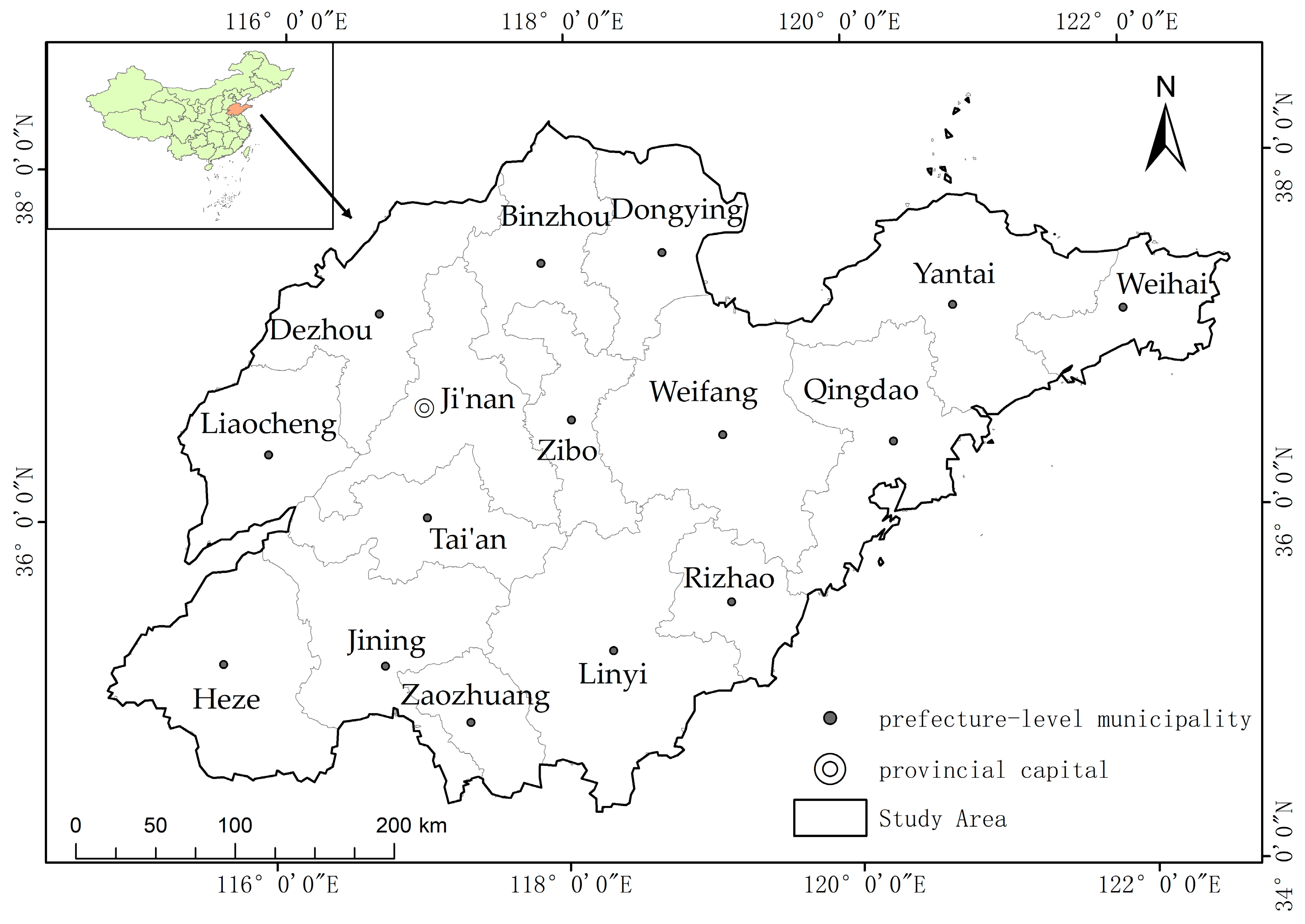
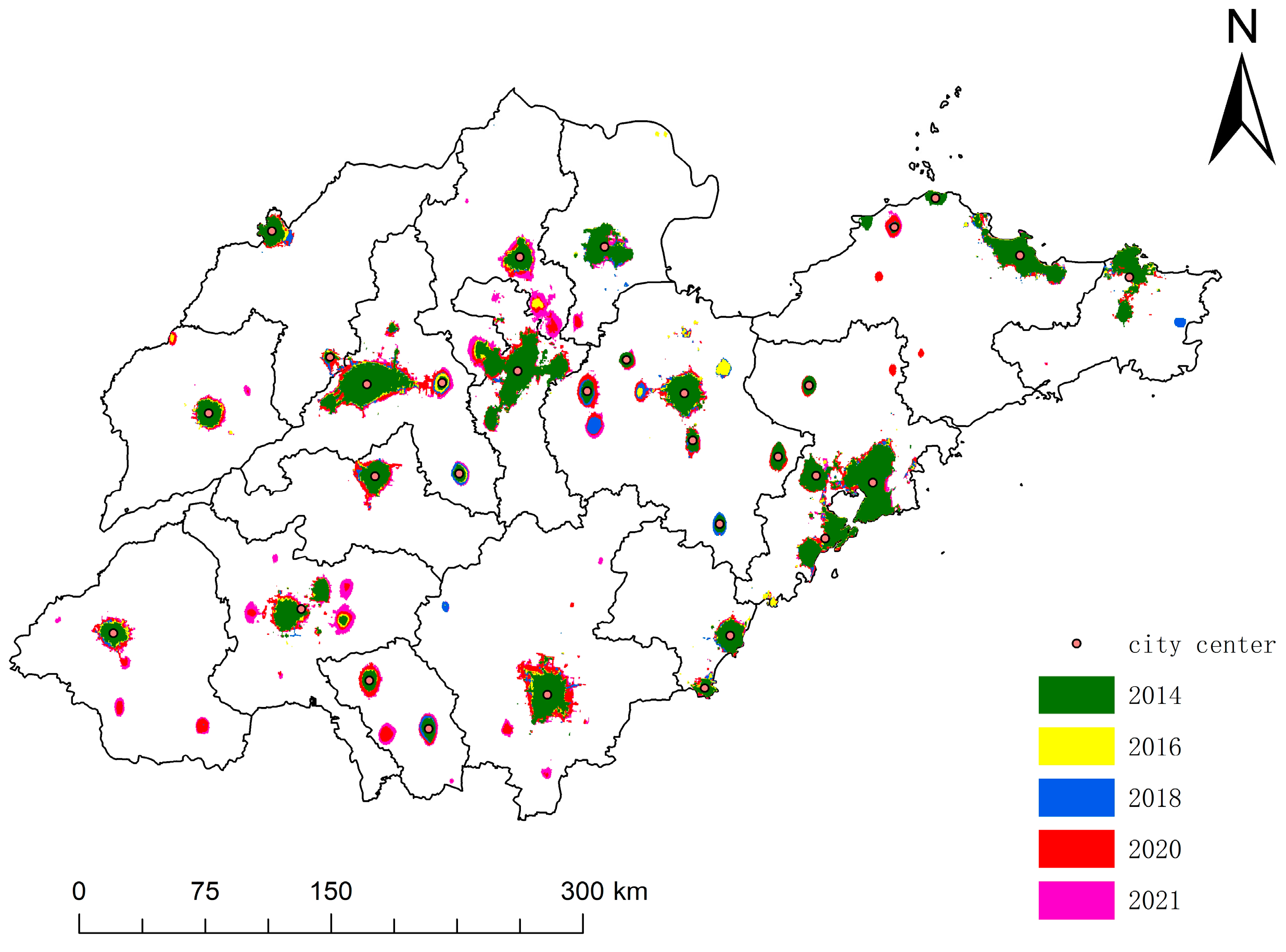
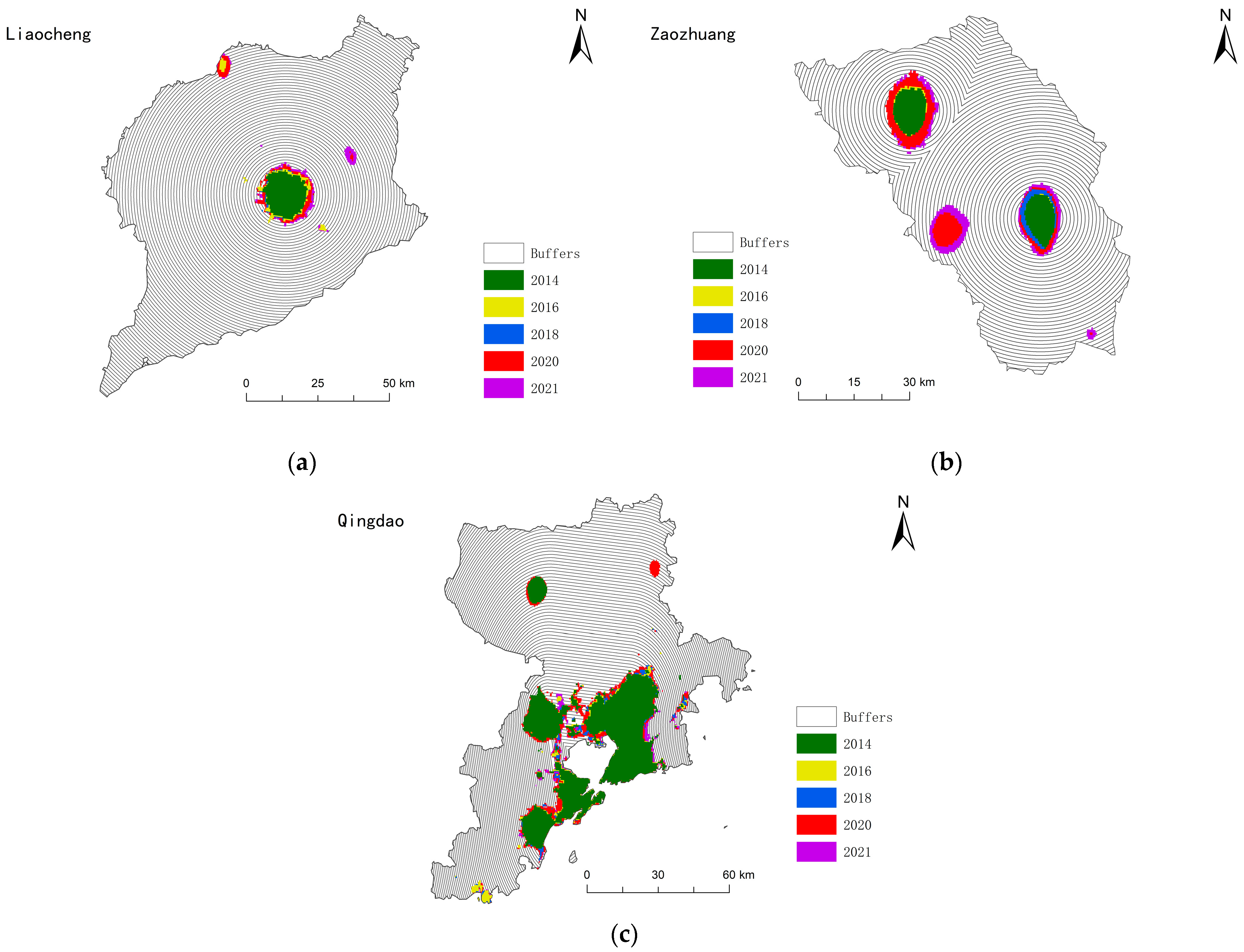
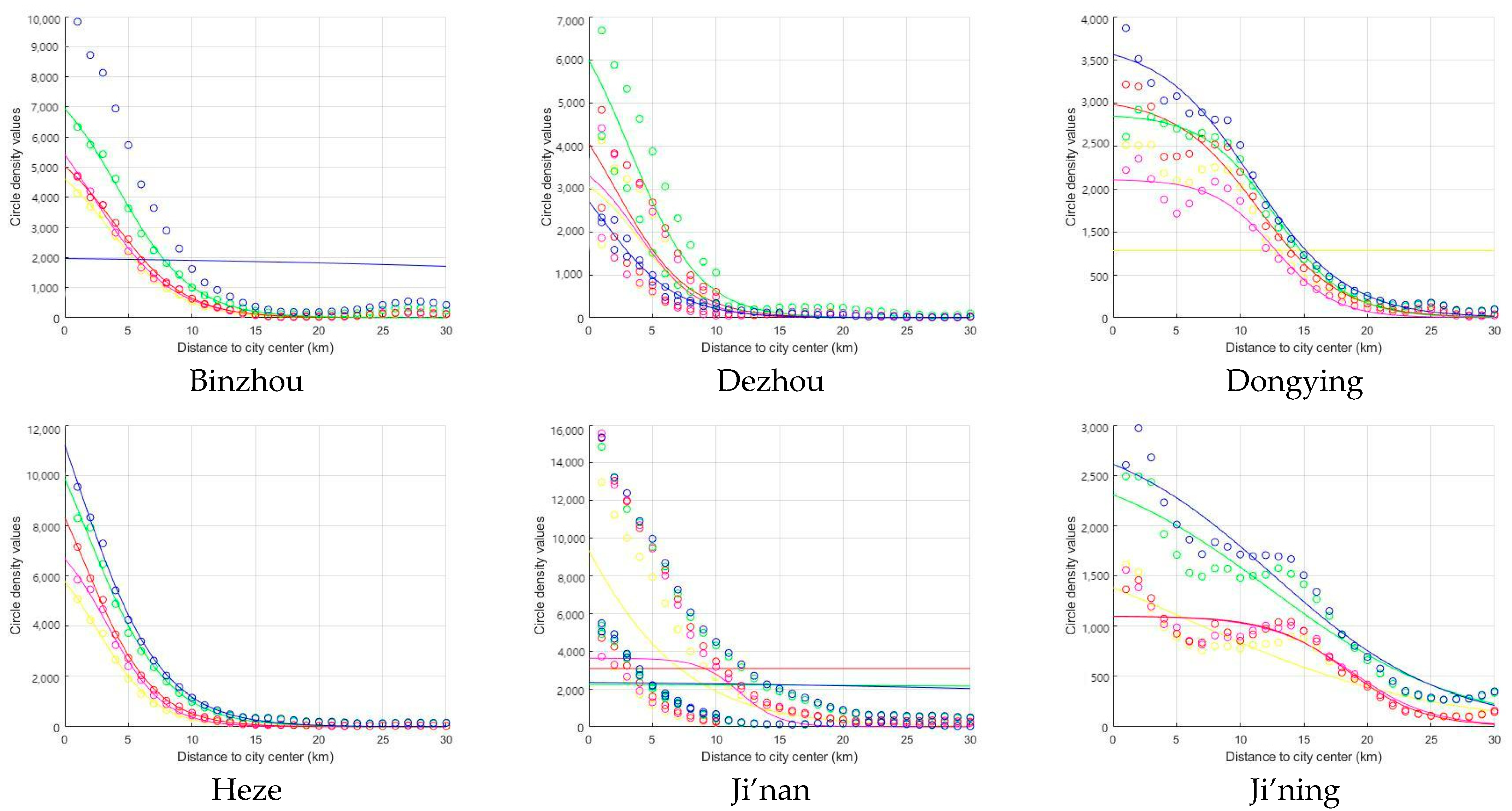
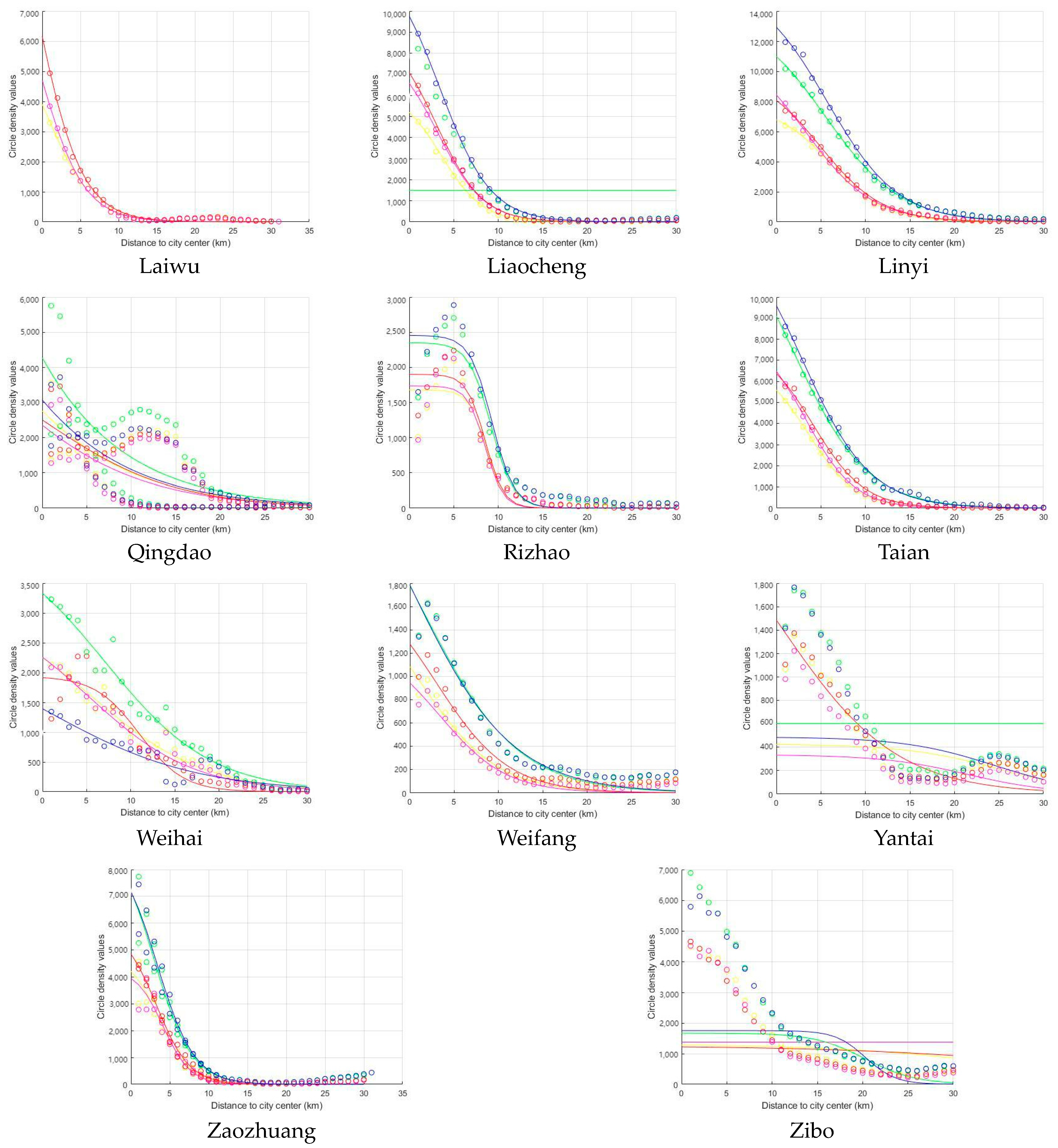
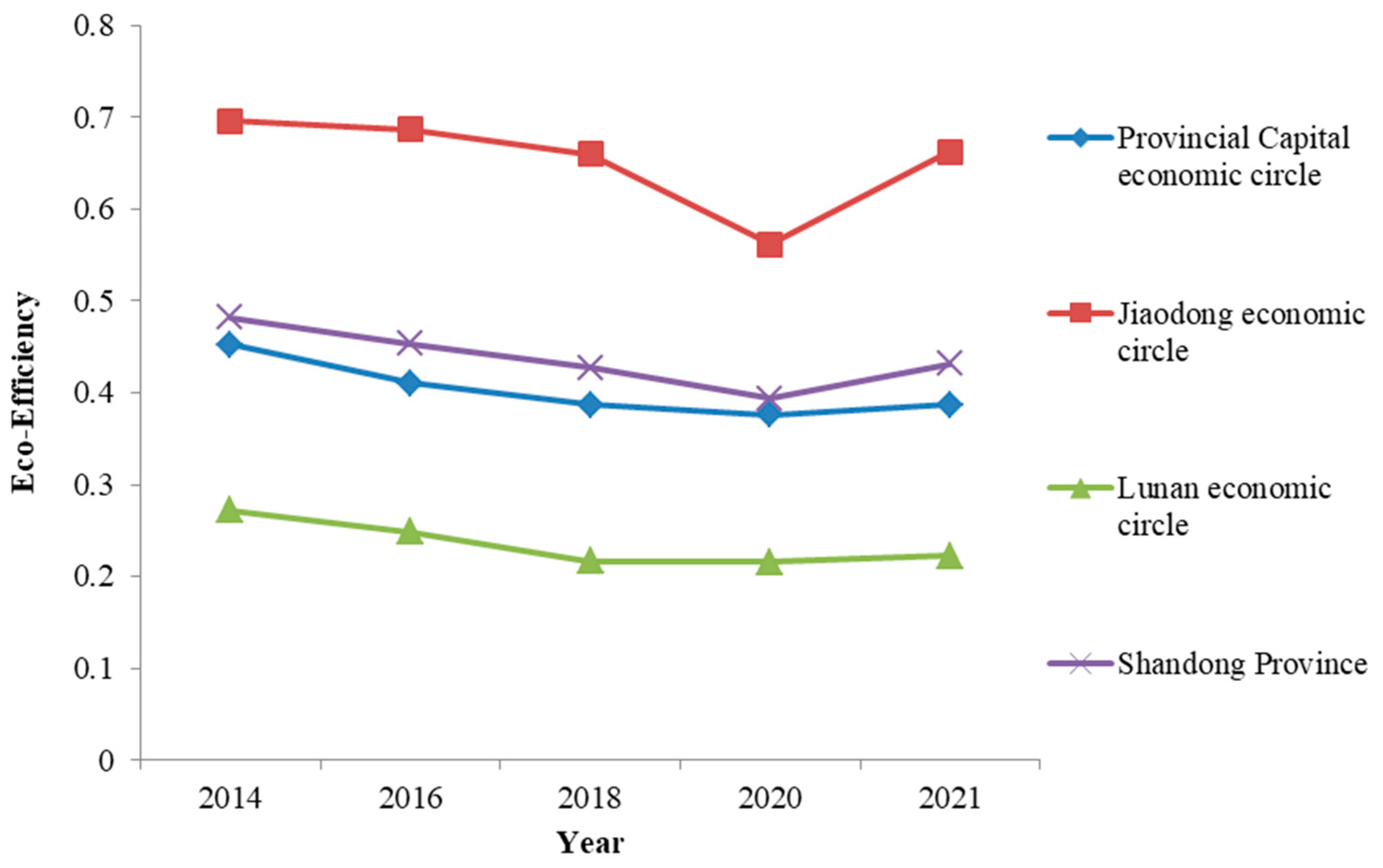
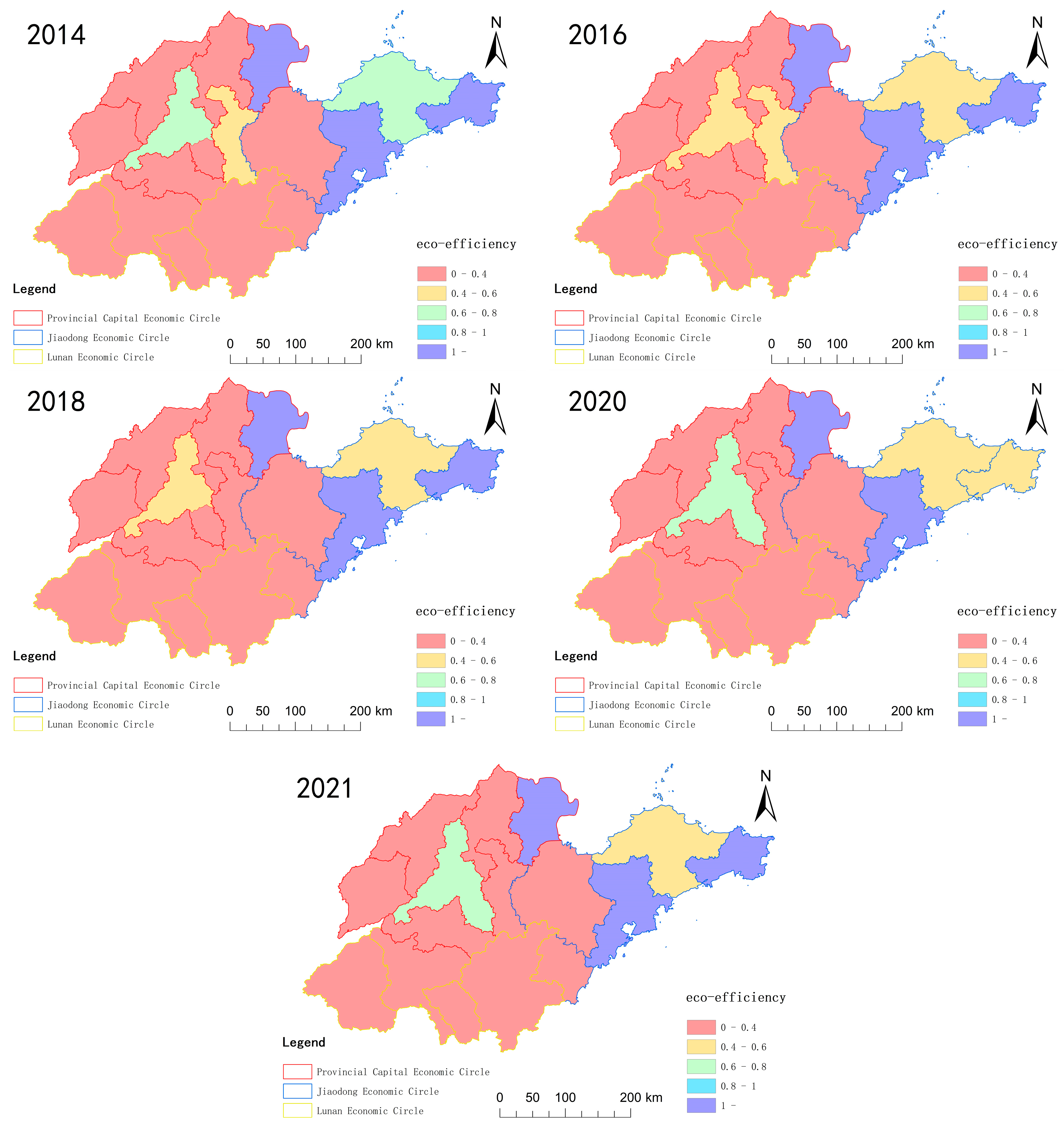
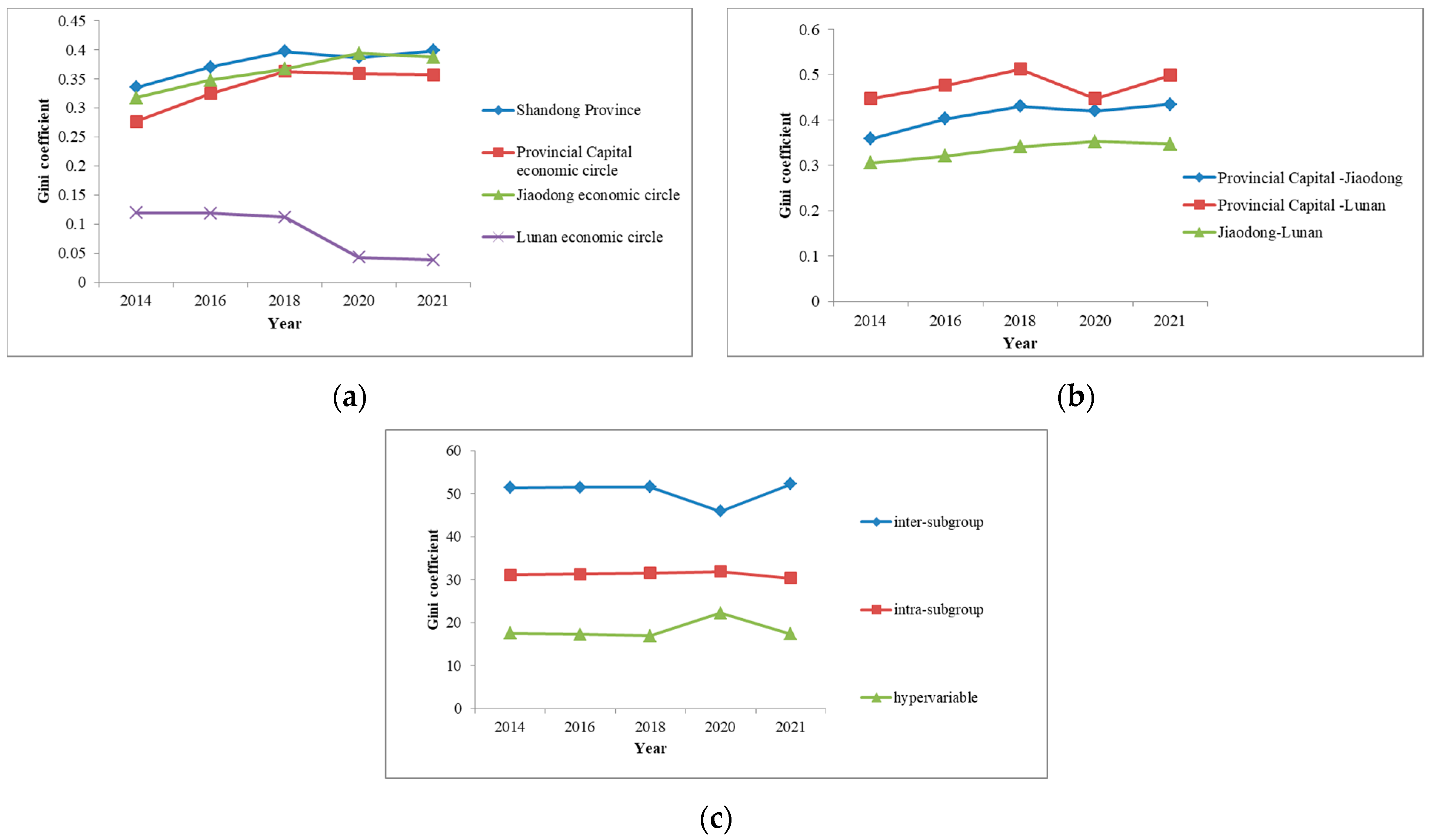
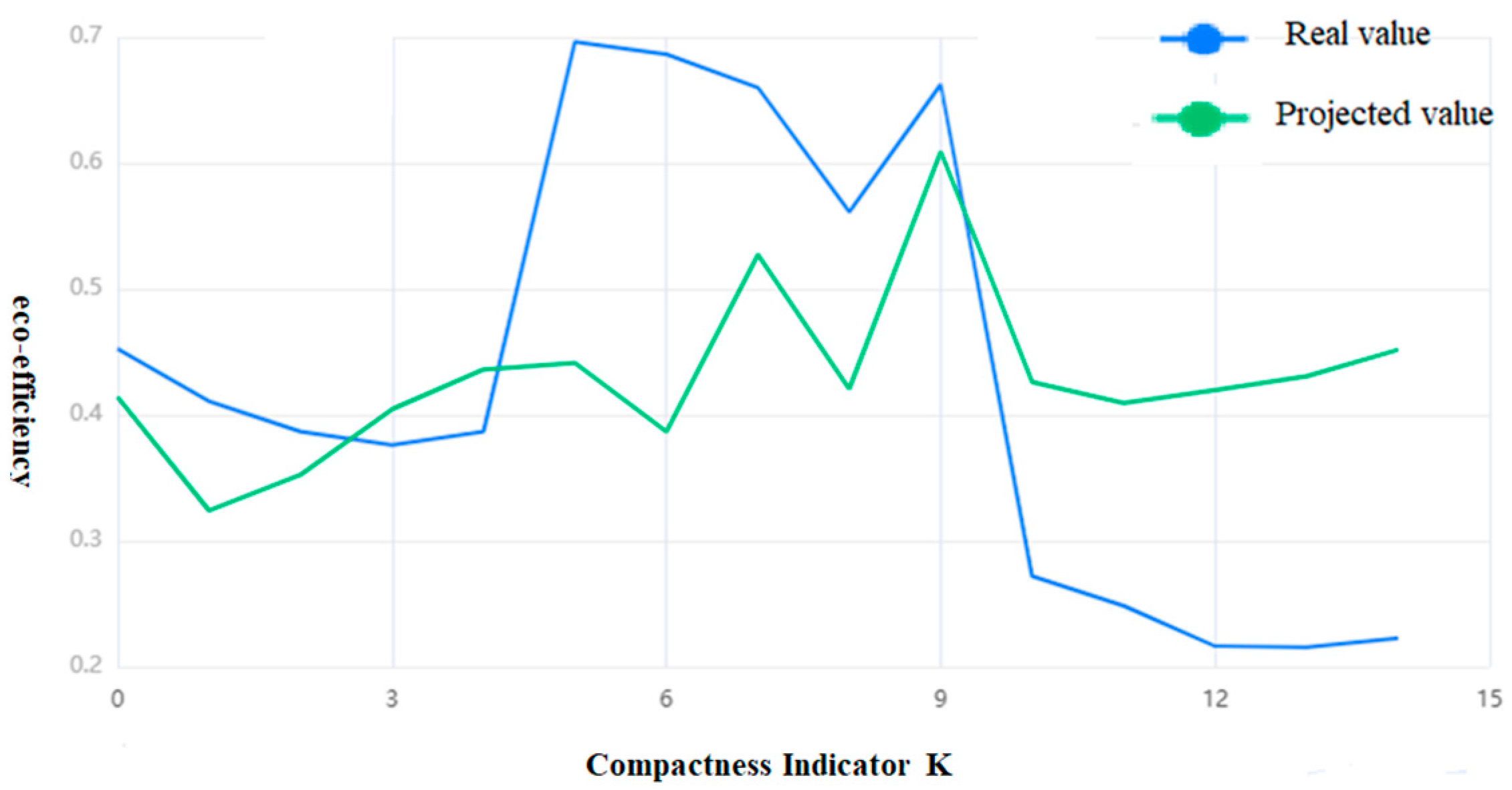
| Variable | Unit | Mean Value | Standard Deviation | Min | Max |
|---|---|---|---|---|---|
| Labor force | 10,000 persons | 360.12 | 165.78 | 84.7 | 722.6 |
| Energy | 100 million kw × h | 352.49 | 236.29 | 102.4 | 1240.5 |
| Water resource | 100 million cubic meters | 12.7 | 5.99 | 2.8 | 23.5 |
| Land | hectare | 175,240.76 | 76,938.46 | 39,567 | 354,460 |
| GDP deflator | 100 million yuan | 1089.97 | 662.61 | 198.97 | 2977.31 |
| Wastewater | 10,000 t | 8893.15 | 5304.19 | 1210 | 27,101 |
| SO2 | t | 35,706.33 | 37,503.44 | 2692 | 184,431 |
| Economic development level | 10,000 yuan/person | 1.95 | 0.51 | 0.808 | 3.0499 |
| Industrial structure | % | 46.36 | 6.77 | 30 | 61.7 |
| Cultural and educational level | % | 2.5 | 0.7 | 1.3 | 4.2 |
| Scientific and technological development level | % | 0.23 | 0.14 | 0.5 | 0.9 |
| Name | 2014 | 2016 | 2018 | 2020 | 2021 | Average K-Value (Outlier Elimination) |
|---|---|---|---|---|---|---|
| Ji’nan | 1.1324 | 0.4120 | 0.4927 | 0.2708 | 0.2573 | 0.35819 |
| Qingdao | 0.9213 | 1.2224 | 0.1062 | 0.7156 | 0.8471 | 0.647569 |
| Zibo | 0.3225 | 0.4886 | 0.3070 | 0.4089 | 0.4466 | 0.394707 |
| Zaozhuang | 0.1483 | 0.2246 | 0.0842 | −0.0364 | 0.0337 | 0.122689 |
| Dongying | 0.4752 | 0.3757 | 0.3123 | 0.3553 | 0.2797 | 0.359644 |
| Yantai | 0.3602 | 0.3522 | −5.5807 | 0.4801 | 0.3631 | 0.38891 |
| Weifang | −2.5648 | −0.2496 | −0.4179 | −1.6654 | 2.14 | 2.14 |
| Jining | −0.5847 | 0.3871 | 0.3929 | 0.1081 | 0.1469 | 0.258733 |
| Tai’an | −0.0008 | −0.0498 | 0.0400 | −0.8550 | −0.3556 | 0.04004 |
| Weihai | −0.2182 | −0.2702 | 0.3501 | −0.0596 | −12.7113 | 0.35006 |
| Rizhao | 0.4268 | 0.4238 | 0.4207 | 0.4101 | 0.4119 | 0.418652 |
| Laiwu | −1.9315 | 3.5623 | 2.3553 | 2.958801 | ||
| Linyi | 0.1683 | −0.2544 | 0.0335 | −0.0030 | 0.0406 | 0.08081 |
| Dezhou | 0.1346 | 0.1050 | −0.3865 | −0.0669 | −1.6749 | 0.119798 |
| Liaocheng | 0.0807 | −0.0389 | −0.0548 | 0.4892 | −0.0401 | 0.284985 |
| Binzhou | −0.0238 | −0.4316 | 0.0222 | 0.0415 | 0.2533 | 0.105666 |
| Heze | −0.0967 | 0.0592 | −0.5746 | −0.6452 | −1.7884 | 0.059192 |
| Year | Shandong Province | Provincial Capital Economic Circle | Jiaodong Economic Circle | Lunan Economic Circle |
|---|---|---|---|---|
| 2014 | 0.33573 | 0.27704 | 0.31746 | 0.11929 |
| 2016 | 0.37024 | 0.32517 | 0.34788 | 0.11893 |
| 2018 | 0.3972 | 0.36313 | 0.36695 | 0.11184 |
| 2020 | 0.38677 | 0.3591 | 0.39387 | 0.042539 |
| 2021 | 0.39873 | 0.35722 | 0.38728 | 0.038269 |
| Year | Provincial Capital–Jiaodong | Provincial Capital–Lunan | Jiaodong–Lunan |
|---|---|---|---|
| 2014 | 0.35841 | 0.4473 | 0.30512 |
| 2016 | 0.40277 | 0.47654 | 0.32027 |
| 2018 | 0.42999 | 0.51236 | 0.34065 |
| 2020 | 0.41947 | 0.44733 | 0.3524 |
| 2021 | 0.43452 | 0.49811 | 0.34696 |
| Year | Inter-Subgroup | Intra-Subgroup | Hypervariable |
|---|---|---|---|
| 2014 | 51.3584 | 31.097 | 17.5446 |
| 2016 | 51.4455 | 31.3112 | 17.2433 |
| 2018 | 51.4914 | 31.5413 | 16.9673 |
| 2020 | 45.86 | 31.9151 | 22.2249 |
| 2021 | 52.2395 | 30.3727 | 17.3878 |
| Quartile 0.2 | Quartile 0.3 | Quartile 0.4 | Quartile 0.5 | Quartile 0.6 | Quartile 0.7 | Quartile 0.8 | ||
|---|---|---|---|---|---|---|---|---|
| Jiaodong Economic Circle | const | −0.881 (0.551) | −1.678 (0.106) | −2.384 (0.016 **) | −2.798 (0.015 **) | −2.06 (0.088 *) | −2.157 (0.041 **) | −1.812 (0.263) |
| ln_Per_GDP | 0.664 (0.279) | 1.092 (0.035 **) | 1.346 (0.005 ***) | 1.12 (0.024 **) | 1.275 (0.014 **) | 1.235 (0.008 ***) | 1.438 (0.022 **) | |
| In_Str | −0.006 (0.818) | −0.012 (0.580) | −0.014 (0.513) | 0.014 (0.569) | −0.004 (0.881) | 0.006 (0.798) | −0.008 (0.814) | |
| Edu_Per | 13.693 (0.778) | 27.291 (0.419) | 41.967 (0.141) | 23.382 (0.418) | 15.507 (0.590) | 12.004 (0.616) | 6.077 (0.856) | |
| Res_Per | −74.699 (0.577) | −111.694 (0.324) | −131.697 (0.207) | −108.558 (0.356) | −79.334 (0.532) | −131.62 (0.267) | −91.51 (0.625) | |
| R² | 0.331 | 0.409 | 0.464 | 0.494 | 0.553 | 0.58 | 0.583 | |
| const | 0.216 (NaN) | 0.206 (0.049 **) | 0.27 (0.008 ***) | 0.401 (0.001 ***) | 0.356 (0.000 ***) | 0.36 (0.001 ***) | 0.379 (NaN) | |
| ln_Per_GDP | 0.116 (NaN) | 0.125 (0.086 *) | 0.105 (0.107) | 0.078 (0.235) | 0.095 (0.075 *) | 0.081 (0.072 *) | 0.044 (NaN) | |
| Lunan Economic Circle | In_Str | −0.003 (NaN) | −0.004 (0.330) | −0.003 (0.384) | −0.002 (0.527) | −0.002 (0.534) | −0.001 (0.731) | 0.001 (NaN) |
| Edu_Per | −2.228 (NaN) | −1.632 (0.683) | −2.205 (0.547) | −6.168 (0.135) | −5.615 (0.105) | −6.198 (0.092 *) | −8.002 (NaN) | |
| Res_Per | 40.236 (NaN) | 40.446 (0.100) | 8.664 (0.664) | 18.921 (0.387) | 13.745 (0.436) | 14.877 (0.492) | 15.819 (NaN) | |
| R² | 0.523 | 0.492 | 0.51 | 0.563 | 0.62 | 0.666 | 0.706 | |
| const | −0.25 (0.137) | −0.042 (0.822) | −0.295 (0.252) | −0.299 (0.295) | −0.281 (0.360) | −0.23 (0.461) | −0.204 (0.515) | |
| ln_Per_GDP | 0.31 (0.000 ***) | 0.301 (0.000 ***) | 0.565 (0.000 ***) | 0.551 (0.000 ***) | 0.554 (0.000 ***) | 0.544 (0.000 ***) | 0.552 (0.000 ***) | |
| In_Str | 0.003 (0.218) | 0.001 (0.619) | −0.006 (0.068*) | −0.005 (0.187) | −0.006 (0.146) | −0.005 (0.172) | −0.006 (0.150) | |
| Provincial Capital Economic Circle | Edu_Per | −7.002 (0.038 **) | −10.31 (0.012 **) | −3.421 (0.529) | −2.642 (0.672) | −1.002 (0.886) | −2.596 (0.710) | −2.204 (0.776) |
| Res_Per | −22.531 (0.101) | −23.035 (0.069 *) | −31.089 (0.034 **) | −37.982 (0.028 **) | −42.382 (0.022 **) | −41.542 (0.031 **) | −43.143 (0.054 *) | |
| R² | 0.395 | 0.439 | 0.495 | 0.596 | 0.672 | 0.729 | 0.771 | |
| const | −0.154 (0.156) | −0.282 (0.026 **) | −0.177 (0.270) | −0.413 (0.057 *) | −0.34 (0.135) | −0.563 (0.071 *) | −0.803 (0.092 *) | |
| ln_Per_GDP | 0.243 (0.000 ***) | 0.288 (0.000 ***) | 0.384 (0.000 ***) | 0.577 (0.000 ***) | 0.563 (0.000 ***) | 0.623 (0.000 ***) | 0.641 (0.000 ***) | |
| Shandong Province | In_Str | 0.004 (0.020 **) | 0.004 (0.071 *) | −0.002 (0.386) | −0.006 (0.087 *) | −0.007 (0.100) | −0.002 (0.694) | 0.001 (0.875) |
| Edu_Per | −5.166 (0.062 *) | −2.827 (0.379) | −0.76 (0.849) | 4.285 (0.410) | 3.098 (0.555) | 2.306 (0.731) | 5.3 (0.524) | |
| Res_Per | −28.84 (0.007 ***) | −32.728 (0.004 ***) | −37.955 (0.003 ***) | −46.599 (0.006 ***) | −44.323 (0.010 ***) | −54.325 (0.017 **) | −17.526 (0.363) | |
| R² | 0.288 | 0.314 | 0.345 | 0.404 | 0.459 | 0.493 | 0.525 |
Disclaimer/Publisher’s Note: The statements, opinions and data contained in all publications are solely those of the individual author(s) and contributor(s) and not of MDPI and/or the editor(s). MDPI and/or the editor(s) disclaim responsibility for any injury to people or property resulting from any ideas, methods, instructions or products referred to in the content. |
© 2024 by the authors. Licensee MDPI, Basel, Switzerland. This article is an open access article distributed under the terms and conditions of the Creative Commons Attribution (CC BY) license (https://creativecommons.org/licenses/by/4.0/).
Share and Cite
Yu, M.; Xu, S.; Zhou, F.; Xu, H. A Study on the Relationship between Urban Spatial Structure Evolution and Ecological Efficiency in Shandong Province. Appl. Sci. 2024, 14, 818. https://doi.org/10.3390/app14020818
Yu M, Xu S, Zhou F, Xu H. A Study on the Relationship between Urban Spatial Structure Evolution and Ecological Efficiency in Shandong Province. Applied Sciences. 2024; 14(2):818. https://doi.org/10.3390/app14020818
Chicago/Turabian StyleYu, Mingyang, Shuai Xu, Fangliang Zhou, and Haiqing Xu. 2024. "A Study on the Relationship between Urban Spatial Structure Evolution and Ecological Efficiency in Shandong Province" Applied Sciences 14, no. 2: 818. https://doi.org/10.3390/app14020818
APA StyleYu, M., Xu, S., Zhou, F., & Xu, H. (2024). A Study on the Relationship between Urban Spatial Structure Evolution and Ecological Efficiency in Shandong Province. Applied Sciences, 14(2), 818. https://doi.org/10.3390/app14020818






